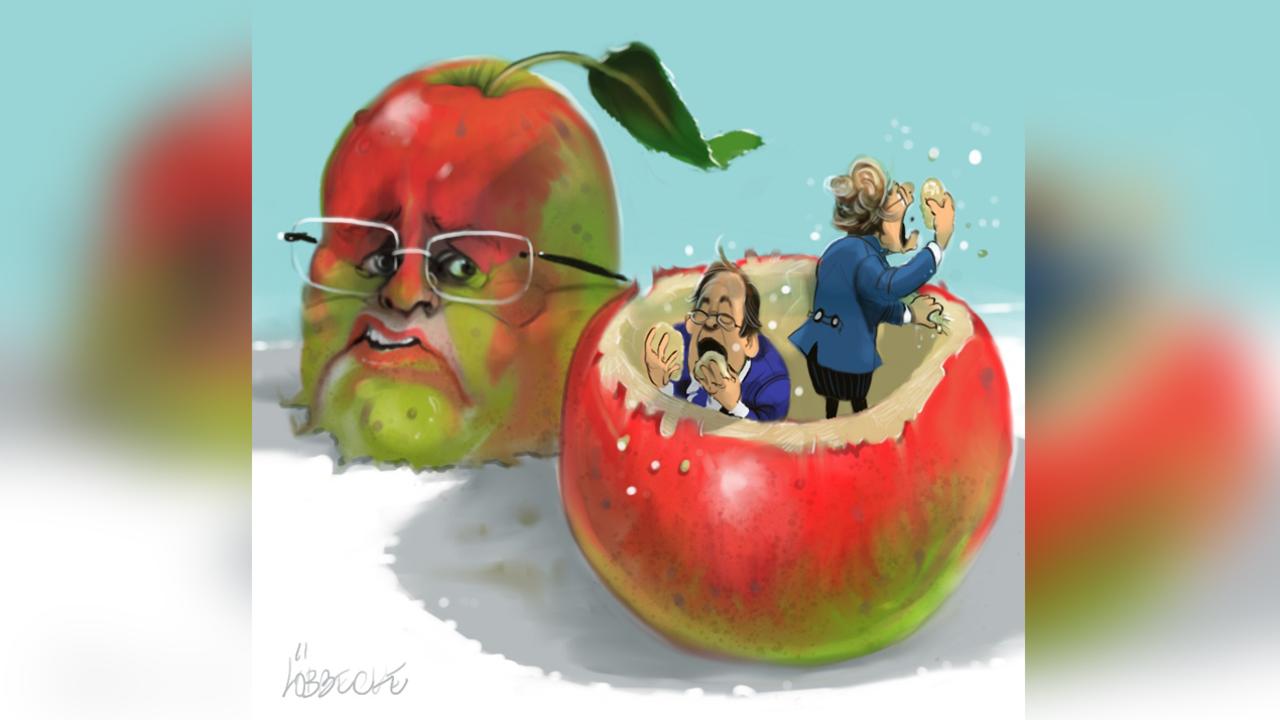
WITH Clive Palmer, Labor and the Greens combining to destroy the government’s budget, it is important to understand just how serious our fiscal crisis is.
In the recession that began in 1974, which lifted the unemployment rate to 6.5 per cent, there were 6 years of consecutive budget deficits with a cumulative deficit amounting to 7.9 per cent of GDP.
The even more severe ‘recession we had to have’ of 1990-1992, in which the unemployment rate rose to 11 per cent, caused 7 years of consecutive budget deficits and a cumulative deficit of 17.2 per cent of GDP.
Now, despite an unprecedented period of low unemployment and continuous expansion, by 2017-18 we will have run deficits for 10 years in a row.
And if the government’s proposed savings measures are not implemented, the cumulative deficit to 2017-18 will climb to 20.5 per cent of GDP, exceeding that incurred in every previous downturn, including the great depression.
The legacy of cumulative deficits will be rising gross debt, which, even with the savings measures, is expected to increase from $360 billion in 2014-15 to $450 billion in 2017-18.
As well as shifting on to tomorrow’s taxpayers the burden of paying for today’s benefits, greater debt will limit the borrowing capacity of future governments, reducing their scope to use fiscal policy to cushion the impact of adverse shocks.
Moreover, with the Reserve Bank’s cash rate already close to zero, the ability of monetary policy to pick up the slack will itself be constrained.
As a result, when an adverse shock comes, the cuts will have to be deeper and the hardship more widespread and prolonged. And such shocks are not merely possible; they are probable.
The historical record is clear: deep falls in output may be unpredictable, but they are hardly uncommon.
A recent study by John Williams, president of the Federal Reserve Bank of San Francisco, examines the 17 advanced economies (including Australia) for which good-quality data is available from the 1890s on. Williams concludes that on average, a contraction as drastic as that the US experienced at the peak of the global financial crisis occurs about once every 19 years. Yes, Williams notes, the sustained expansion that preceded the GFC suggested recessions had virtually been abolished; but like dreams of eternal peace, that illusion was soon shattered, and with a vengeance.
To Australians, basking in the sunshine of seemingly unending growth, the warnings of economic history will appear remote.
But recent decades are an unreliable guide to the challenges that lie in wait.
Rather, the stellar performance of the last 23 years at least partly reflects a series of one-off factors. To begin with, the depth of the recession ‘‘we had to have’’ meant there was a lengthy period in which the economy was simply climbing back towards its trend level. In 1992, national output was nearly 3 per cent below trend; it took until 1998 before the ‘‘output gap’’ (the difference between actual and trend output) was largely closed.
At the same time, structural reform, including labour market deregulation, lifted the economy’s productive potential, extending the growth spurt into the early years of this century. As that momentum faded, the aftermath of the ‘‘tech wreck’’ saw activity dip slightly below trend from 2001 to 2003; but the investment phase of the mining boom then came to the rescue, pushing output and incomes above trend in every year except 2010 and 2011.
However, at least as far as Australia is concerned, heaven may be running low on manna. For sure, the spectacular growth the boom has allowed in our capital stock, which increased by 60 percent in a decade, will permit durably higher levels of production; but the growth rate of that production could well taper off within five to six years.
Additionally, at the turn of this century, barely half of our exports went to Asia; now, four-fifths do. The scope to expand exports by redirecting trade from slowly growing to very rapidly growing markets is correspondingly smaller, with China’s eventual transition towards less dependence on resources
accentuating that effect.
And last but not least, the Rudd and Gillard governments saddled our economy with labour market regulations that punish the young and unskilled, raise unemployment, reduce labour force participation and limit the level and growth of incomes.
None of that condemns us to sackcloth and ashes.
But it does make the current policy paralysis, which entrenches roadblocks to growth and increases our vulnerability to downturns, particularly costly; and it means that counting on ever greater prosperity to redress the nation’s fiscal predicament is not mere complacency but outright recklessness.
The parallels to the experience in Britain should make the situation all the more disturbing. After a recession in 1990-91, a sustained recovery, combined with tighter controls over public expenditure, allowed a sequence of budget surpluses.
Unfortunately, by 2002 the Labour government had lost its fiscal discipline, and surpluses gave way to red ink; but with the deficits only 2 to 3 per cent of GDP, Labour steadfastly dismissed them as inconsequential, especially since the financial boom gave Tony Blair’s “Cool Britannia’’ an aura of invulnerability.
So when the crisis emerged with the collapse of the Northern Rock bank in September 2007, mounting public debt made drastic spending cutbacks inevitable, pushing the unemployment rate to 8 per cent and resulting in a prolonged period of slow growth.
Putting Australia’s house in order now, when the economy’s continuing strength can help absorb the costs of orderly fiscal consolidation, is therefore nothing more than prudent risk management.
And there is no mystery about what needs to be done.
Projections for public spending tell the story.
On average, commonwealth government payments have been about 24.9 per cent of GDP.
But unless reductions are made in the growth of public expenditure, cumulative payments to 2024-25 will exceed that benchmark by over $250 billion, corresponding to nearly $10,000 per man, woman and child.
To fund those payments, the tax burden would need to rise to well above its long-term level, with the typical full-time worker on average weekly earnings facing an income tax rate more than five percentage points higher than that in 2014-15.
And as they will be paying payroll taxes, compulsory superannuation contributions and the GST on top of that, average wage earners would therefore be losing well over half of any additional income earned in tax, reducing the incentives to work and save.
But in addition to being economically distorting, intense political competition means high levels of taxation will be hard to implement and sustain.
Rather, if spending is not brought under control, the likelihood is that the run of deficits will continue — until, that is, a severe downturn forces us into far-reaching retrenchment, just as has occurred in every previous bout of debt accumulation.
It is absurd to claim, as the visiting American economist Joe Stiglitz has, that a proposed gradual return to fiscal sustainability will worsen inequality.
On the contrary, the greatest threat to the living standards of the poor and vulnerable would come from forcing Australia into a European scenario, where drastic austerity has greatly increased poverty in every country that has felt its effects.
Far from being a recipe for fairness, allowing our fiscal woes to fester can only ensure the ultimate pain is both greater and more inequitable.
Indeed, this is why Norway, whose egalitarianism Stiglitz holds up as an example for Australia, has pursued the most fiscally conservative policies in Europe.
Even more exposed than we are to the commodity price cycle, it has guarded against recurrent deficits and strenuously avoided public debt.
The difficulty, therefore, does not lie in knowing what should be done; rather, it is in finding a way to do it, and for the government, to do so at a manageable political cost.
Labor lacked the willingness and ability that requires; the Coalition, which does want to tackle the problems, risks finding it impossible.
After all, chaos is Palmer’s best friend, while Labor’s sole concern is to prevent Abbott succeeding at what it so spectacularly failed to do.
Averting an eventual fiscal crisis hardly figures in the goals of those who do not make policy, but nonetheless have the power to break it.
Confronted with those dangers, the words of Joseph Schumpeter, the great economist who served as Austria’s finance minister in the trauma that followed the end of World War I, come to mind.
The ‘‘fiscal constitution’’ of a country, Schumpeter wrote, encapsulates in its highest form ‘‘the spirit of a people, its cultural level, its social structure, the deeds its policy may prepare’’.
‘‘He who knows how to listen’’ will discern in its ability to deal with fiscal difficulties ‘‘the thunder of its history more clearly than anywhere else’’.
With that thunder rolling, Australians have every reason to fear the storms that lie ahead.



